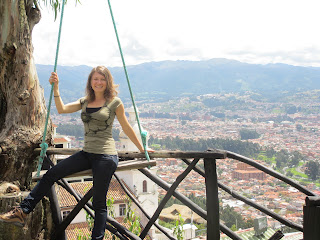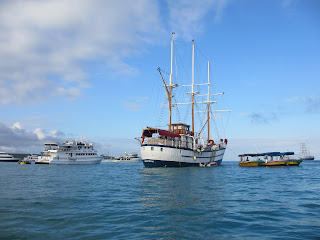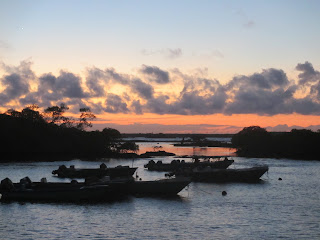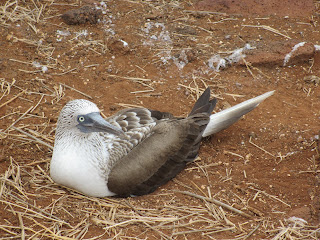Ecuador: Trekking, Festivals & the Middle of the World
Hola a todos,
Guayaquil & Riobamba
Once Leslie and I returned from The Galapagos, we spent an afternoon in Guayaquil and then headed for Riobamba with hopes to catch a train called The Devil’s Nose. This train was supposed to pass through beautiful scenery and is famous for allowing tourists to ride on the roof. Unfortunately, part of the train line was suspended for repairs, so we spent one night in Riobamba and traveled straight to Lataguna for the next part of our journey.
Latacunga & The Quilotoa Loop
 |
| Quilotoa crafter |
The city of Latacunga is not much to talk about, but has a nice view of snowcapped volcanoes. It’s also a great starting point for the “Quilotoa Loop”, a trekking circuit of small towns nestled in the mountains. Leslie and I decided on a three-day journey (two days of trekking) and packed up our bags with what we thought we would need. I personally could have packed less.
“Turn Right After the Big Rock”
Our first day, we bussed it to Quilotoa and checked out the Quilotoa crater lake, where we began our quest. I felt like we were in the Lord of the Rings. Our trek instructions read, “Climb to the top of the lake and glance across the water. You should see three sandy spots. Your goal is to get to the second sandy spot. Walk around the lake until you reach the second sandy spot...once you get to the two big rocks, turn right. Don’t turn left as that trail goes down.” Suddenly every spot looked sandy and there were numerous big rocks. Later on, we had to remember to turn right after a river. But, did river really mean river or did it mean creek?
 |
| First guests at the Wicunto Hostel in Guaymas |
Staying with the Locals
The serendipitous stay was lovely. The group took us in and showed us their farm and renovations to the old Spanish hacienda. They also gave us a tour of the garden, introduced us to new vegetables, like the oca (a cross between a turnip and a potato), and invited us into one of their homes. Inside, we tried the new veggies and watched the family process cevada (barley) and prepare it with some sugar water to create a porridge.
That evening, we ate dinner and listened to the group sing songs in Quichua (an indigenous language) and Spanish. We went to bed with plenty of blankets, but due to the altitude and cold, I woke up shivering in the middle of the night and it took some time for me to breathe normally.
10-Hour Trek
 |
| Trekking from Chugchilán to Isinliví |
The next morning, our hosts prepared breakfast for us and decided a price to charge us, the first tourists. We began our second day of trekking with a much better sense of where we were going, even though our instructions had not changed.
We set off for the 10-hour trek (we were behind due to getting lost the day before) with our walking stick in hard to fend off any protective dogs and made our way through the mountains and its valleys. We passed Chugchilán and reached Isinlivi before dark.
On our way to Isinlivi, we met a few key “guides”. One guide was a truck driver who was hauling dirt (and men) to and from a small town on our way. We hitched a ride and walked down the indicated path to find another man, an artist. He took us to a lookout point, showed us the path and then showed us his woodwork. He makes furniture for nearby hostels and also etches local scenes out of wood.
White Dogs Everywhere
We walked through a tiny town, said “Buenos Dias” to a group of schoolchildren and hiked beside the river for quite some time until we were soaked with the afternoon showers. Later in the afternoon, we consulted a few houses to make sure we were on the right track, but my favorite was a sweet old woman who lived on a small farm with cornfields surrounding her house. Leslie and I walked up to ask for directions when we saw two white dogs, then four, then eight, then twenty. They seemed to come from nowhere and everywhere. I had my stick ready to protect from any unwanted attacks, but finally the dogs calmed down as the woman yelled at them to hush. Her accent was so thick, it was difficult to understand, but she seemed thrilled that we had come to visit. From her, I received the latest weather update and some ambiguous yet obvious (to the locals!) instructions on how to get to the river and bridge. Shoes drenched and feet exhausted, we arrived at the hostel just in time for dinner.
The Milk Truck Run
 |
| The milk truck |
The next day, Leslie and I hitched a ride on a milk truck, one of my favorite experiences in South America. It was a three-hour ride back to Latacunga (where the rest of our stuff was located) and this truck was tasked with picking up milk from all of the small farms around the area. I loved it because first, you’re riding in the back of an open-air truck bed surrounded by other locals and large barrels of milk. Second, the scenery at 3,000 meters (10,000 feet) is breathtaking - the clouds moving rapidly through the deep blue sky and over the green mountains and the farms speckled throughout the countryside. Finally, the process of milk delivery was great. I had the opportunity to see how the milk was gathered and at times, help close the barrels!
Otavalo
Inti Raymi Festival
Leslie and I went to Otavalo specifically for the Inti Raymi festival, a summer solstice festival, that many local people celebrate each year by going down to the Peguche waterfall around midnight and cleansing themselves. The ritual also includes lots of food, drinks, dancing from house-to-house and Shaman blessings. Leslie and I went with a local couple, Marcos and Aurelie (the Spanish couple we met in the Galapagos), and Bruno from Brazil. The majority of us, including me, participated fully in the rituals. The waterfall water was incredibly cold (about 12 C or 54 F) and it wasn’t much warmer outside, but the experiencing was refreshing.
Afterward, we warmed up by drinking canelazo - a cinnamony drink with or without aguardiente (a sugar cane alcohol) and dancing from house to house. The dance was easy, you just jumped into the circle (around the musicians) and bounced stepping forward until someone turned around and then the entire group starting going the opposite direction. Musicians also jumped in and out of the circle. Most houses were open for this event and we stayed from 10 p.m. to 2 a.m. enjoying the festivities.
Sunday Market
 |
| Guinea pigs for sale |
Otavalo is also famous for its Saturday market, a seemingly endless array of crafts ranging from earrings to blankets to traditional belts and hats. We also ventured over to the animal market, where everything from cows to guinea pigs are sold, generally to eat!
Exploring the Surrounding Area
Apart from the city, we took a jeep tour with Aurelie, Marcos, and Bruno to a, a small town that produces leather and a tree that is said to have healing powers.
After the festivities and the market, Leslie and I set off for the capital of Ecuador, where we would part ways.
Quito
Leslie and I decided to stay in downtown Quito to take in the full glory of Quito’s colonial days.
Downtown
 |
| Main Plaza in Quito |
Nonprofit Tour
Through one of my previous acquaintances, I met with The Lending Journey contact in Quito. The purpose of the organization is to provide microfinancing to small businesses or individuals, usually about $300 to be paid over a six-month period. The lead contact provided us with her experiences working with 200 individuals, including the challenges and successes. She also introduced us to one of their success stories, a woman who sells luggage and backpacks in a local “mall”.
Making my way out....Middle of the World
While traveling to the border of Ecuador and Colombia, I decided to make a very touristy stop at Mitad del Mundo (Middle of the World). Mitad del Mundo claims to be on the equator and as such has built a monument to commemorate the discovery and location. However, there is a private, fun site about 200 meters from the official monument that claims that it is the actual site. I visited both and observed some of the experiments (balancing an egg on a nail, water going straight down a drain instead of counter or clockwise, walking a line and working harder to keep your balance, etc.) that helped support the latter site´s claim!
Observations
 |
| Otavalo´s craft market |
- Quests - I absolutely love a little adventure. For me, it was freeing to venture through mountains and valleys with little more than a walking stick, some barely adequate instructions, a confusing path, and a few locals along the way.
- Nonprofits/NGOs - Not as easy as you think. It´s not enough just to want to help in your own way; the people have to want your help as well.
- Festival - Even as a tourist, I felt welcomed at the Inti Raymi festival. I could easily dance and participate in the festivities.
- Craft Market - In Otavalo, the the craft market was the best I´ve seen anywhere. Cheers to incredible variety and quality!
Next: Venturing into Infamous Colombia!
Saludos,
Ashley
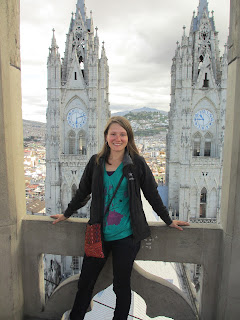 | ||||||||
Gothic cathedral in Quito
|




